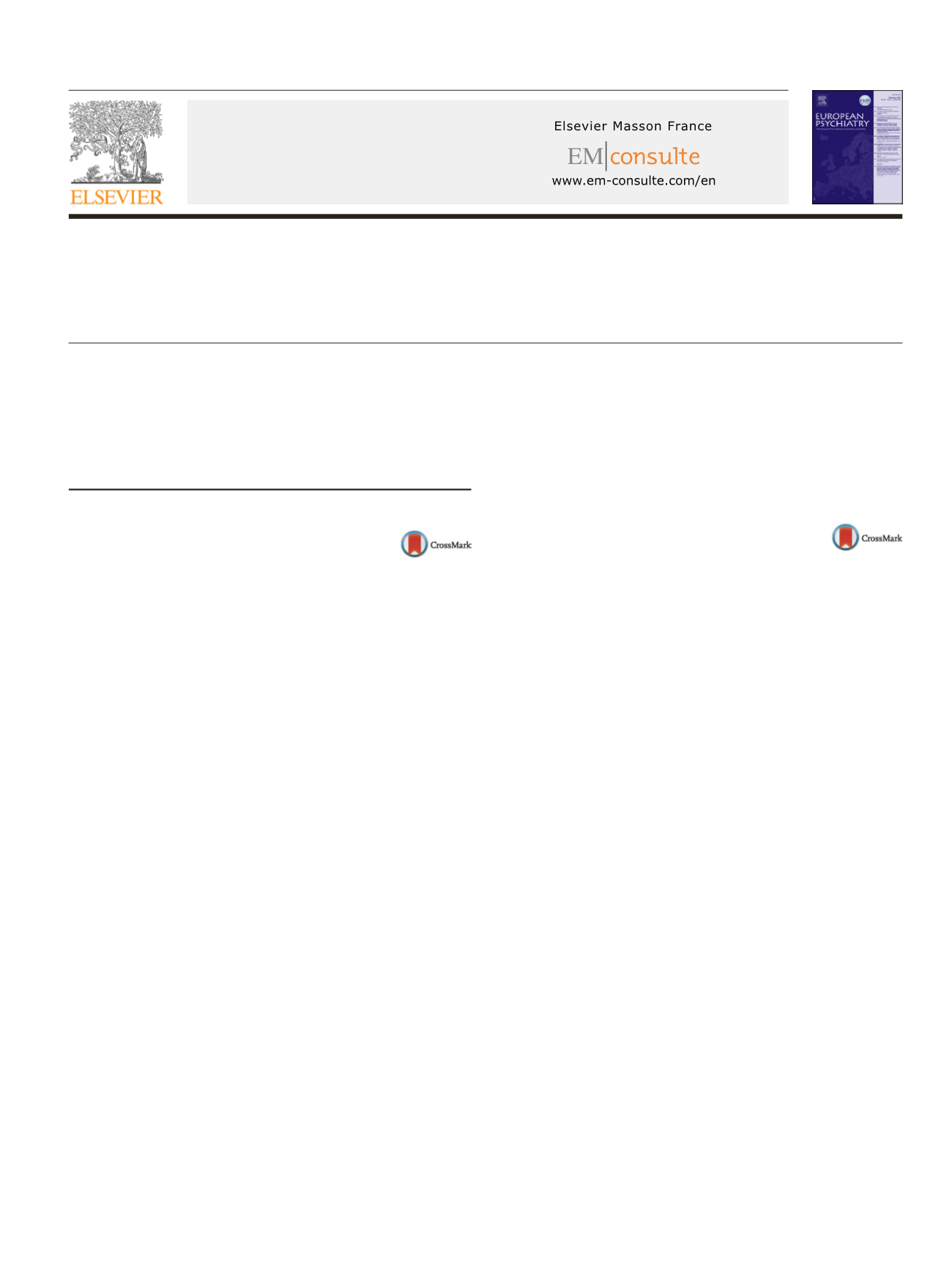
 European Psychiatry 41S (2017) S69–S105
European Psychiatry 41S (2017) S69–S105
Available online at
ScienceDirect
www.sciencedirect.com25th European Congress of Psychiatry
Oral communications
Oral communications: Anxiety disorders and
somatoform disorders; depression;
obsessive-compulsive disorder and personality
and personality disorders
O001
Impact of childhood trauma on the
course of panic disorder
M. De Venter
1 ,∗
, F. Van Den Eede
2, T. Pattyn
3, K. Wouters
4,
D. Veltman
5 , B. Penninx
6 , B. Sabbe
21
University Hospital Antwerp, Psychiatry, Lichtaart, Belgium
2
University Hospital Antwerp, Psychiatry, Edegem, Belgium
3
University of Antwerp UA, Collaborative Antwerp Psychiatric
Research Institute CAPRI, Wilrijk, Belgium
4
University Hospital Antwerp, Department of Scientific Coordination
and Biostat, Edegem, Belgium
5
VU University Medical Center, Department of Psychiatry- EMGO
Institute of Health care research, Amsterdam, The Netherlands
6
University Medical Center Groningen, Psychiatry, Groningen, The
Netherlands
∗
Corresponding author.
Objective
To investigate the impact of childhood trauma on the
clinical course of panic disorder.
Method
Longitudinal data of 539 participants with a current
panic disorder were collected from the Netherlands Study of
Depression and Anxiety (NESDA). Childhood trauma was assessed
with a structured interview and clinical course after two years with
a DSM-IV-based diagnostic interview and the Life Chart Interview.
Results
At baseline, 56.3% reported childhood trauma, but this
was not predictive of persistence of panic disorder. Emotional
neglect and psychological abusewere associatedwithhigher occur-
rence of anxiety disorders other than panic disorder (social phobia)
and with higher chronicity of general anxiety symptoms (anxi-
ety attacks or episodes and avoidance). Baseline clinical features
(duration and severity of anxiety and depressive symptoms) and
personality traits (neuroticism and extraversion) accounted for
roughly 30 to 60% of the total effect of childhood trauma on
chronicity of anxiety symptoms and on occurrence of other anxiety
disorders.
Conclusion
After two years, childhood trauma is associated with
chronicity of anxiety symptoms and occurrence of social phobia,
rather than persistence of panic disorder. These relationships are
partially accounted for by duration and severity of anxiety and
depressive symptoms, and neuroticism and extraversion.
Disclosure of interest
The authors have not supplied their decla-
ration of competing interest.
http://dx.doi.org/10.1016/j.eurpsy.2017.01.223O002
Pharmacological and
psychotherapeutic interventions for
management of post-stroke
depression: A Bayesian network
meta-analysis of 27 randomized
controlled trials
L. Deng
West China Hospital Of Sichuan University, Stroke Clinical Research
Unit, Department of Neurology, Chengdu, China
Background
Post-stroke depression (PSD) constitutes an impor-
tant complication of stroke, leading to great disability as well as
increased mortality. Since which treatment for PSD should be pre-
ferred are still matters of controversy, we aimed to compare and
rank these treatments.
Methods
We did a network meta-analysis to incorporate both
direct and indirect evidence from relevant trials by Bayesian ran-
dom effects model. We searched PubMed, the Cochrane Library
Central Register of Controlled Trials, Scopus, Embase for random-
ized controlled trials of different PSD treatments. The primary
outcomes were efficacy and tolerability. We assessed the quality
of evidence using the GRADE framework.
Result
From 1347 citations, 27 randomised trials with a total of
1620 participants were included in this network meta-analysis.
In terms of primary outcome, only for reboxetione (standardised
mean difference [SMD]
−
12.84, 95% credible interval [CrI]
−
23.13
to
−
2.65) and nortriptyline (SMD
−
7.95, 95% CrI
−
14.85 to
−
1.75)
enough evidence existed to support superiority compared with
placebo. No significant difference was observed in terms toler-
ability. Considering patient response rate, repetitive transcranial
magnetic stimulation (rTMS) was statistically more effective than
sertraline plus nimodipine (Relative risk [RR] 5.53, 95% CrI 1.36 to
23.86) and fluoxetine (RR 10.74, 95% CrI 3.55 to 35.97)
Conclusion
Compared with placebo, reboxetione and nortripty-
line offered a clear advantage for PSD patients. rTMS is probably
the best option to consider in addition of pharmacological treat-
ment. Nevertheless, doctors need to consider our results together
0924-9338/


















